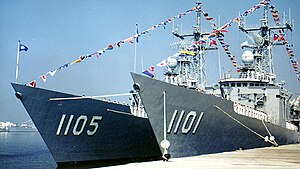ROCS Cheng Kung
 ROCS Cheng Kung alongside ROCS Chi Kuang
| |
| History | |
|---|---|
| Name | ROCS Cheng Kung (FFG-1101) |
| Ordered | 8 May 1989 |
| Builder | |
| Laid down | 21 December 1990 |
| Launched | 5 October 1991 |
| Commissioned | 7 May 1993 |
| Status | in active service |
| General characteristics | |
| Class and type | Cheng Kung-class frigate |
| Displacement | 4,103 tons full |
| Length | 453 ft (138 m) |
| Beam | 46.95 ft (14.31 m) |
| Propulsion | General Electric LM2500-30 gas turbines, 40,000 shp total |
| Speed | 29 knots |
| Complement |
|
| Sensors and processing systems |
|
| Electronic warfare & decoys |
|
| Armament |
|
| Aircraft carried | Sikorsky S-70C-1/2 |
ROCS Cheng Kung (成功, FFG-1101) is the lead ship of eight Cheng Kung-class guided-missile frigates, which are based on the Oliver Hazard Perry-class of United States Navy. Laid down on 2 December 1990 and launched on 27 October 1991, Cheng Kung was commissioned in service on 7 May 1993. All of these Taiwanese FFG's have the length of the later long hull Oliver Hazard Perry FFG's, but have a different weapon and electronics fit.
In order to control the different weapon systems on board that the Mk 92 can't integrate into, a second CDS, H930 MCS was installed on all 8 ships in order to control the 8 HF-2(or 4 HF-2 and 4 HF-3 on PFG-1101 and PFG-1105) and the 2 x Bofors 40mm/L70 guns(except on PFG-1110). Rest of the ships in this class will receive 4 HF-3 upon their major overhaul.
Namesake
Cheng Kung is named after Cheng Ch'eng-kung (鄭成功) (1624 - 1662), who was a military leader at the end of Ming Dynasty that led the recovery of Taiwan from Dutch colonial occupation in 1662.
